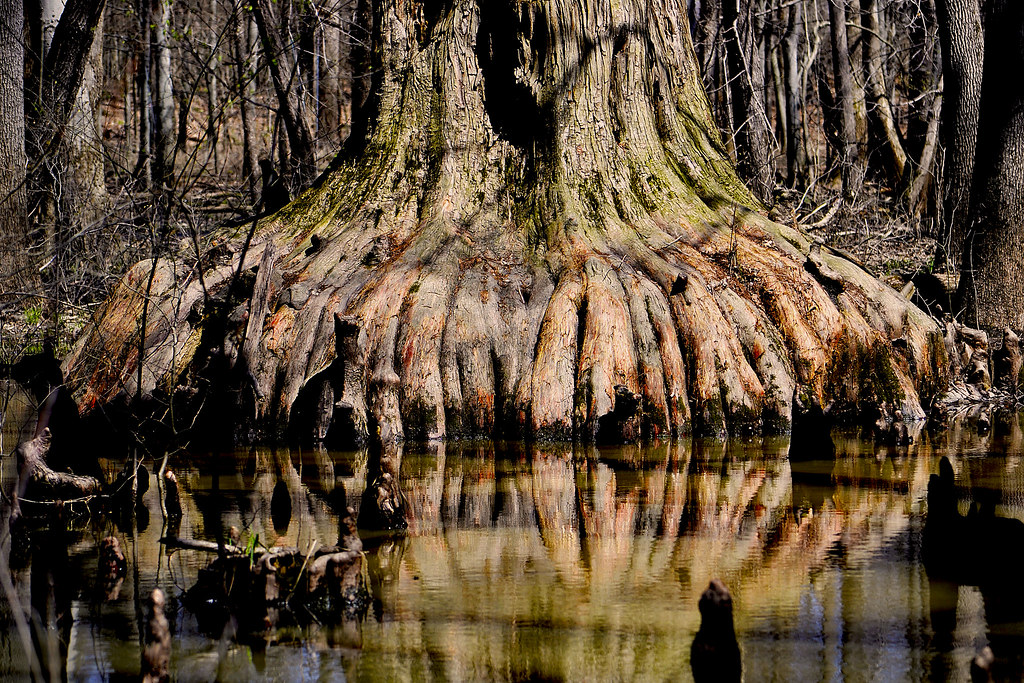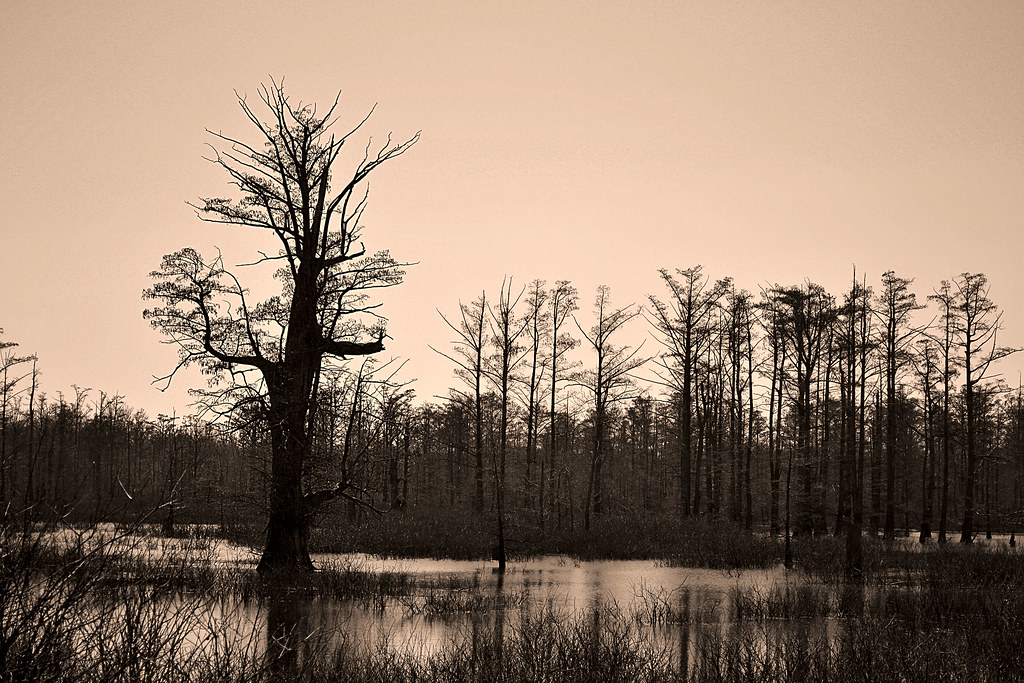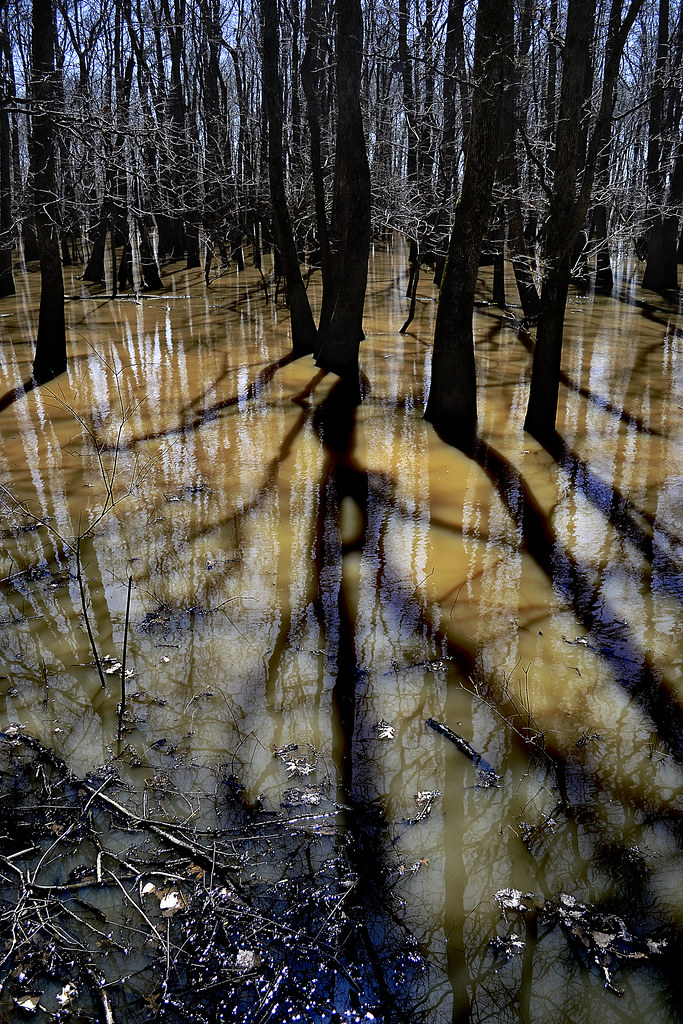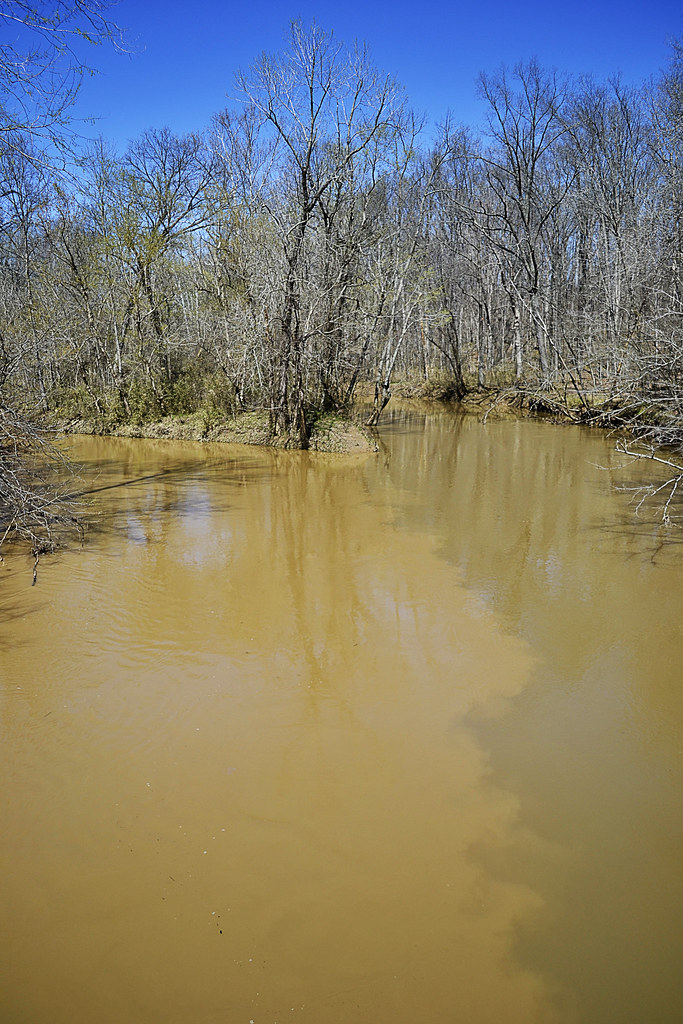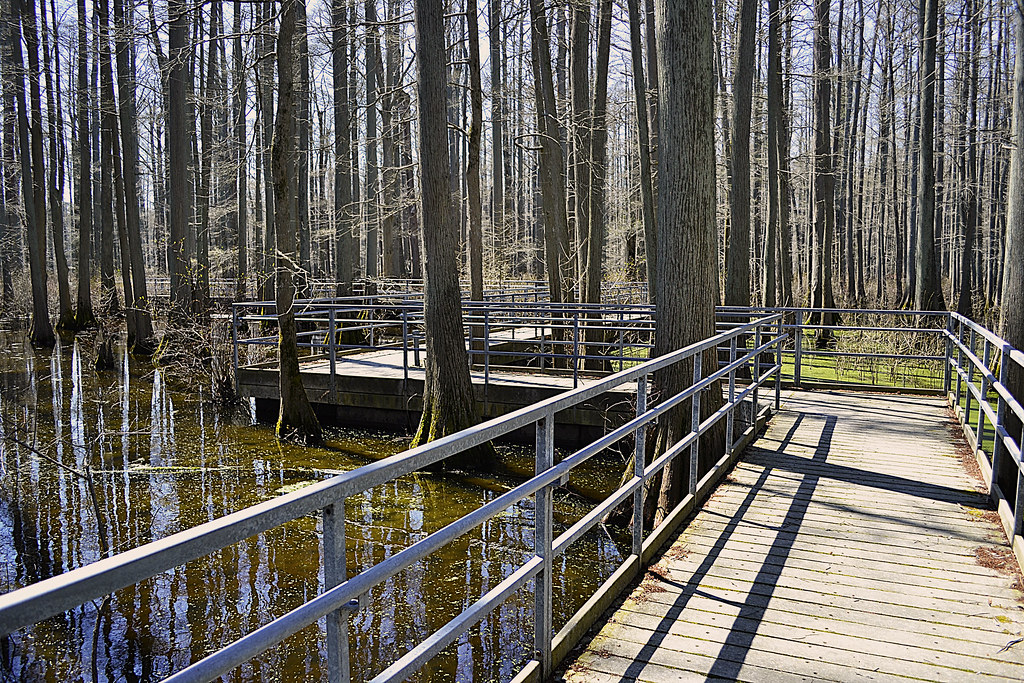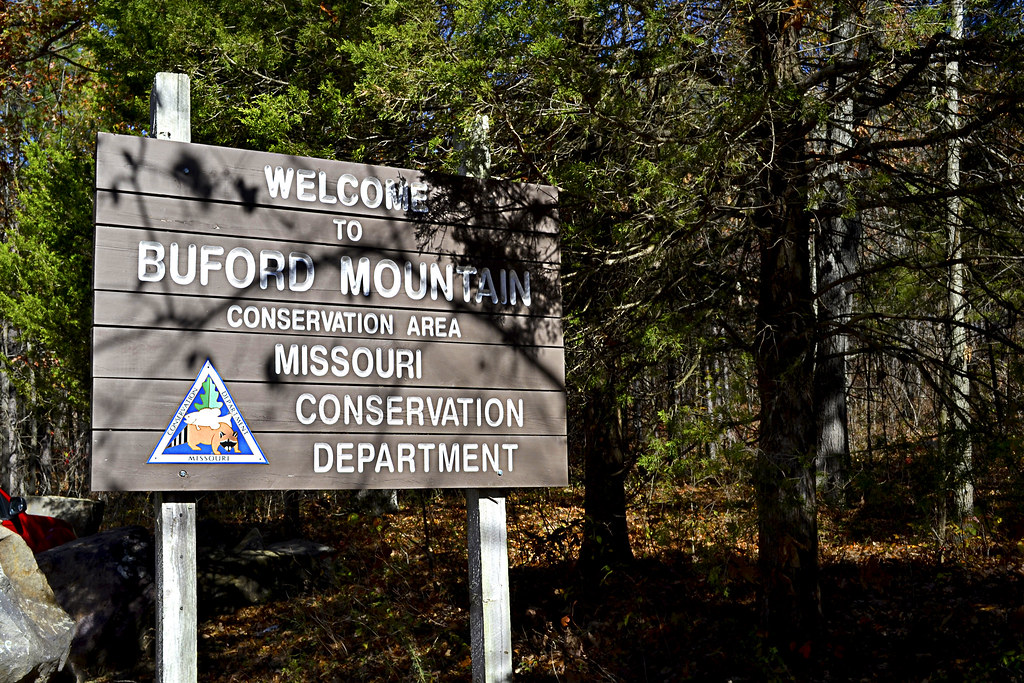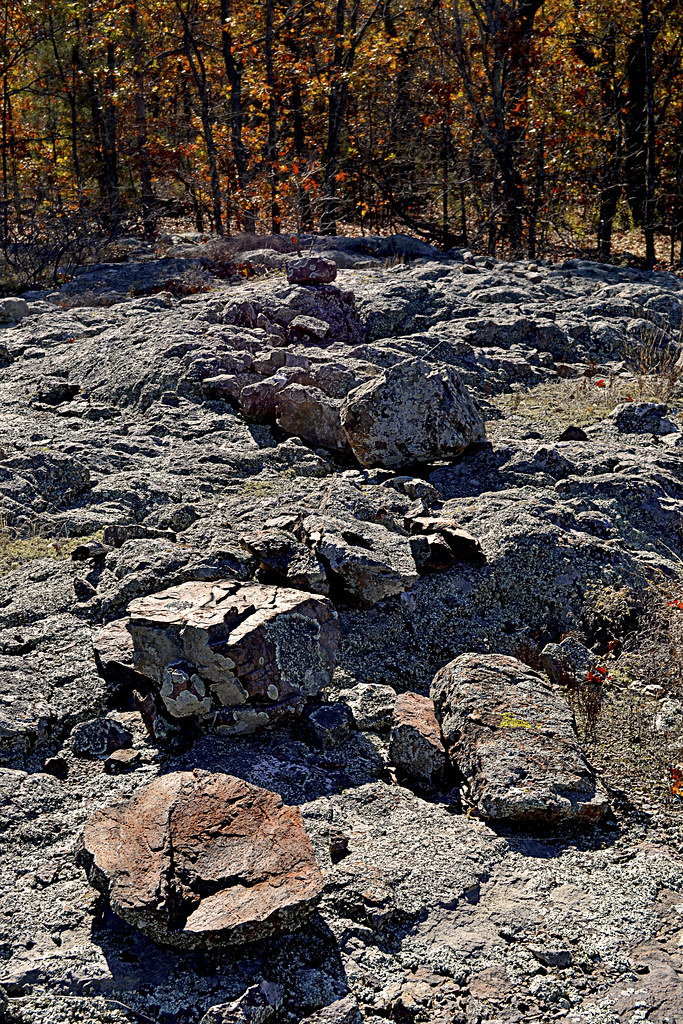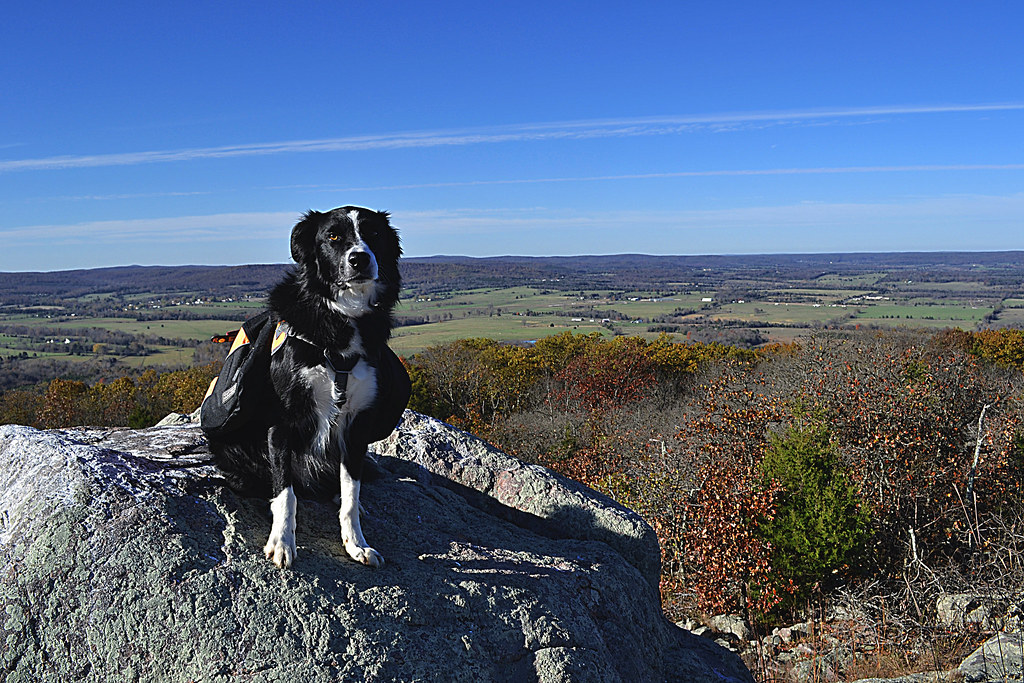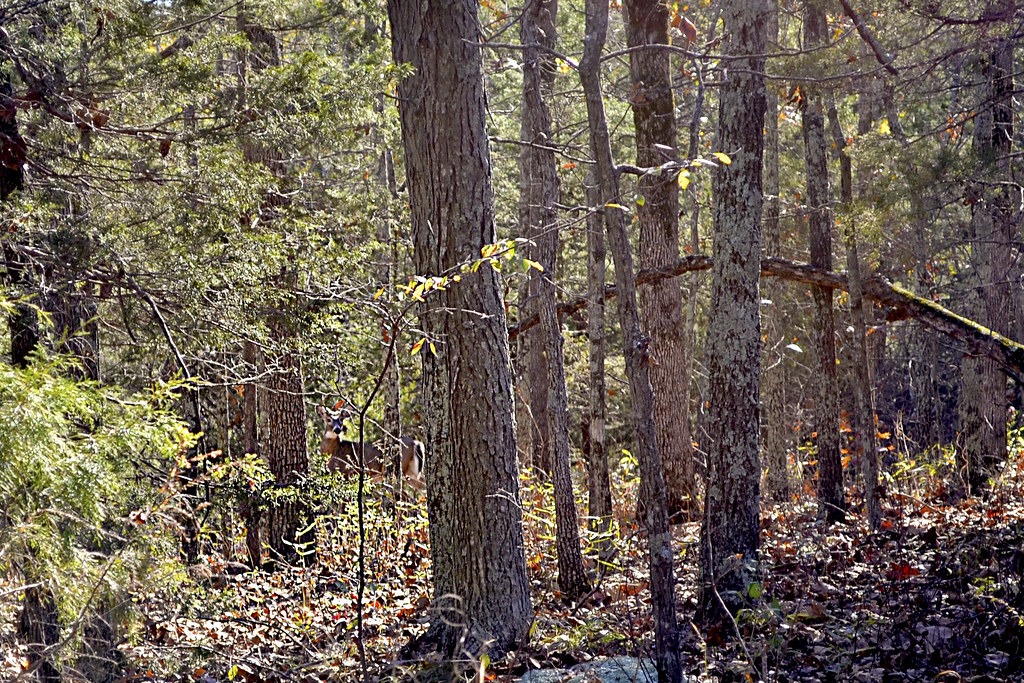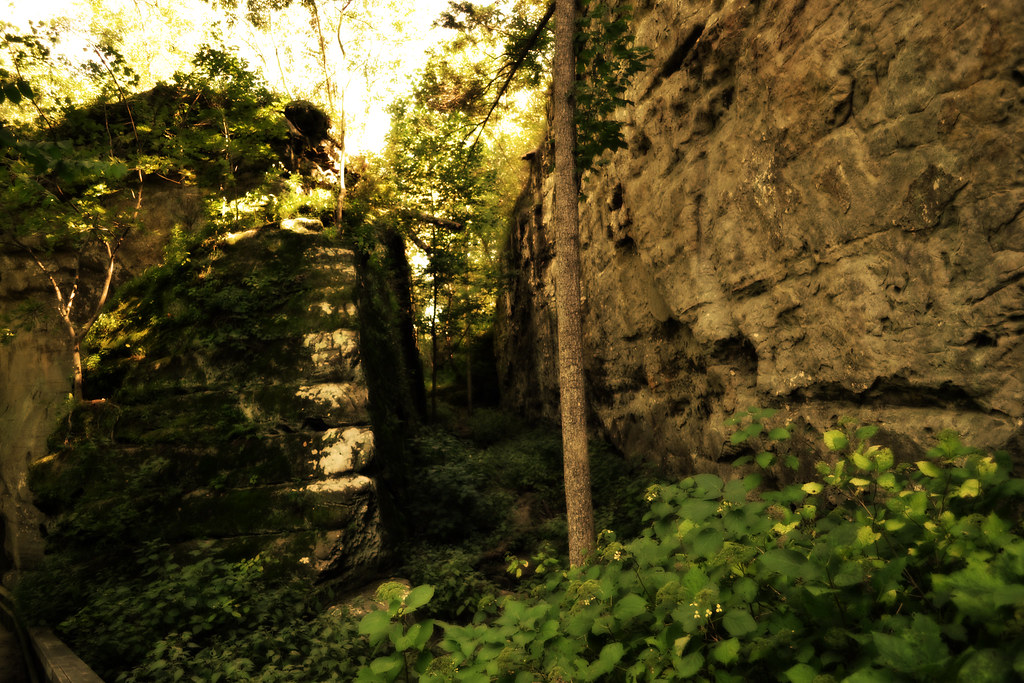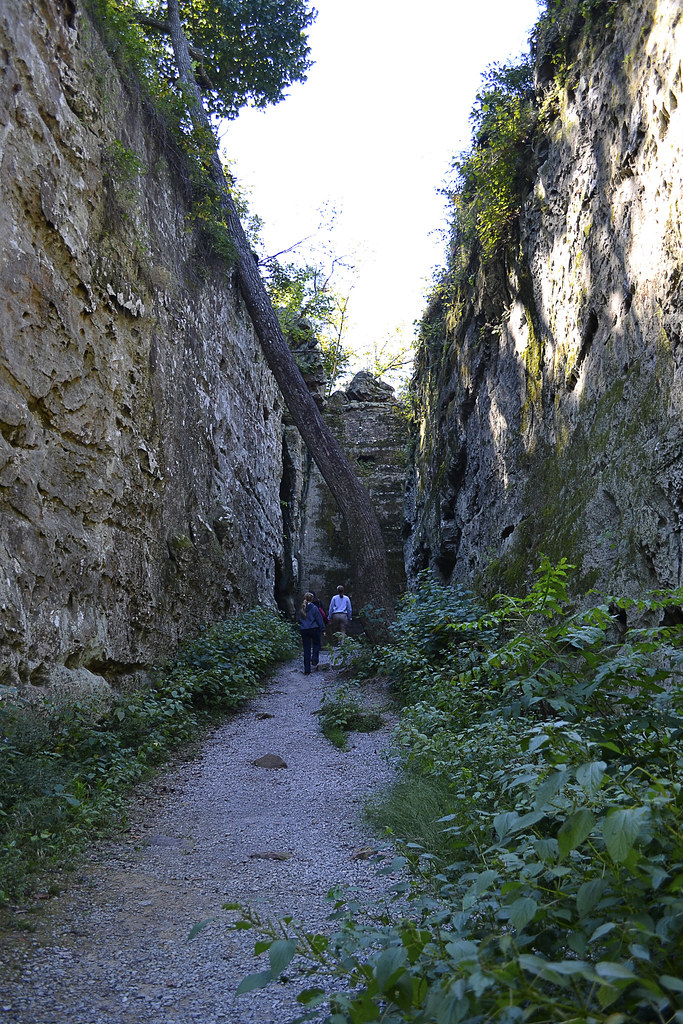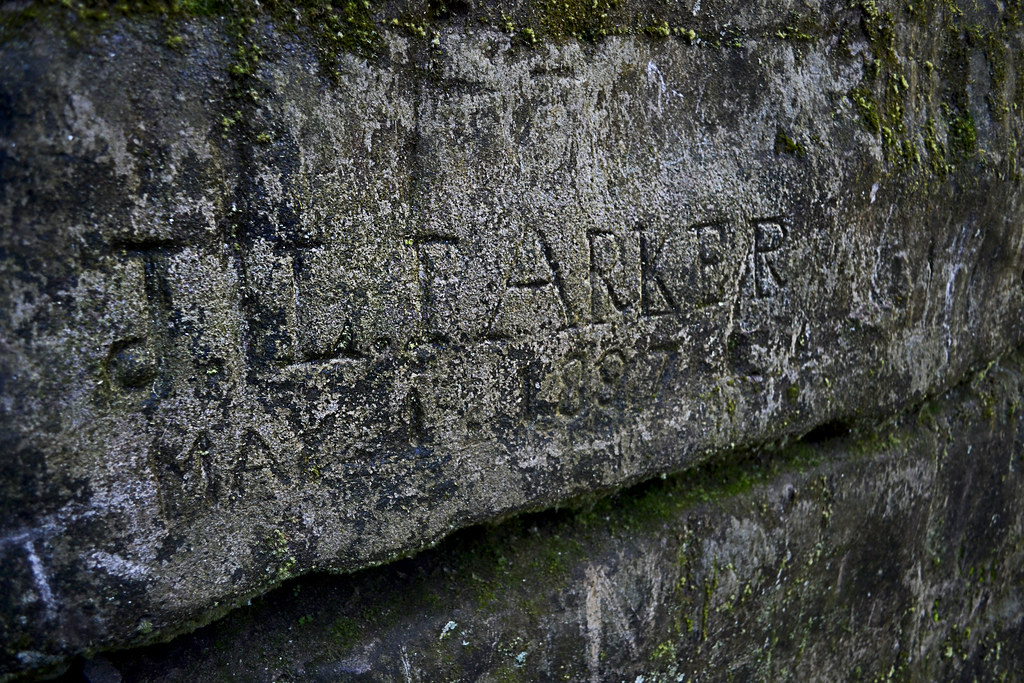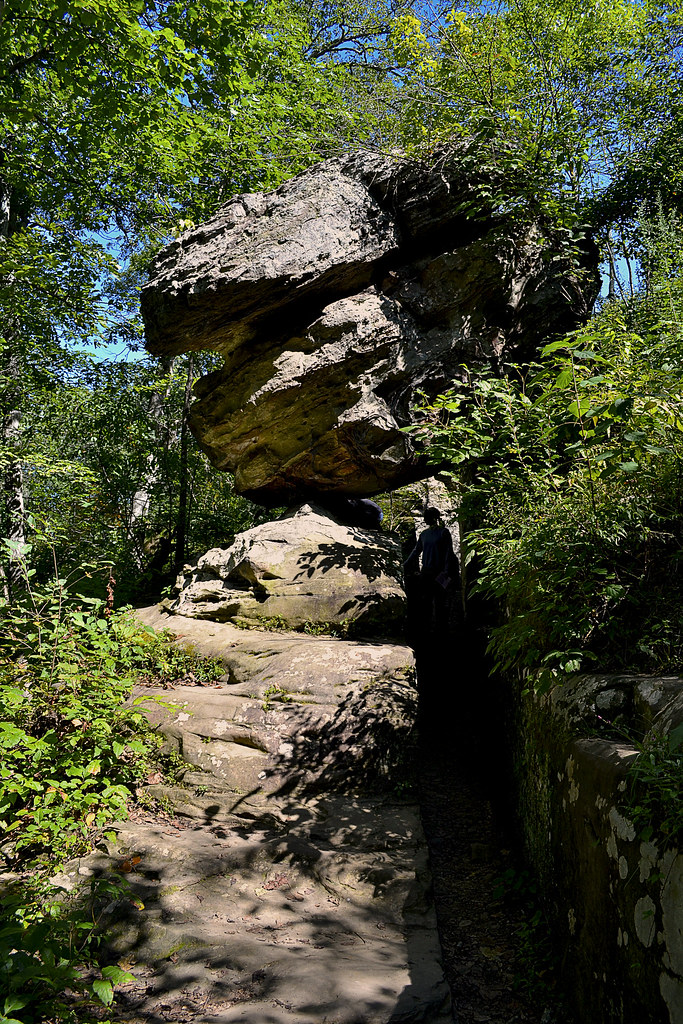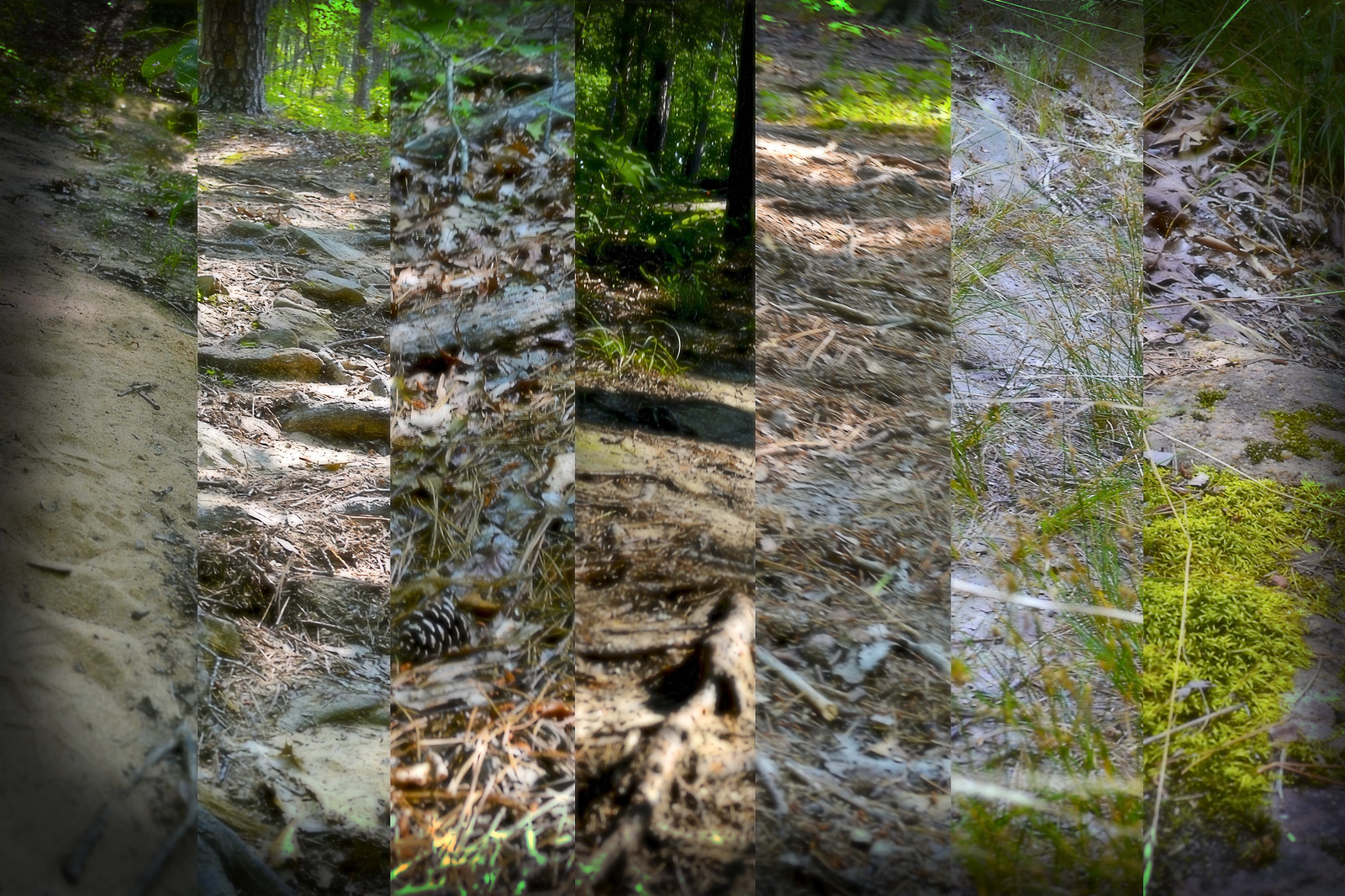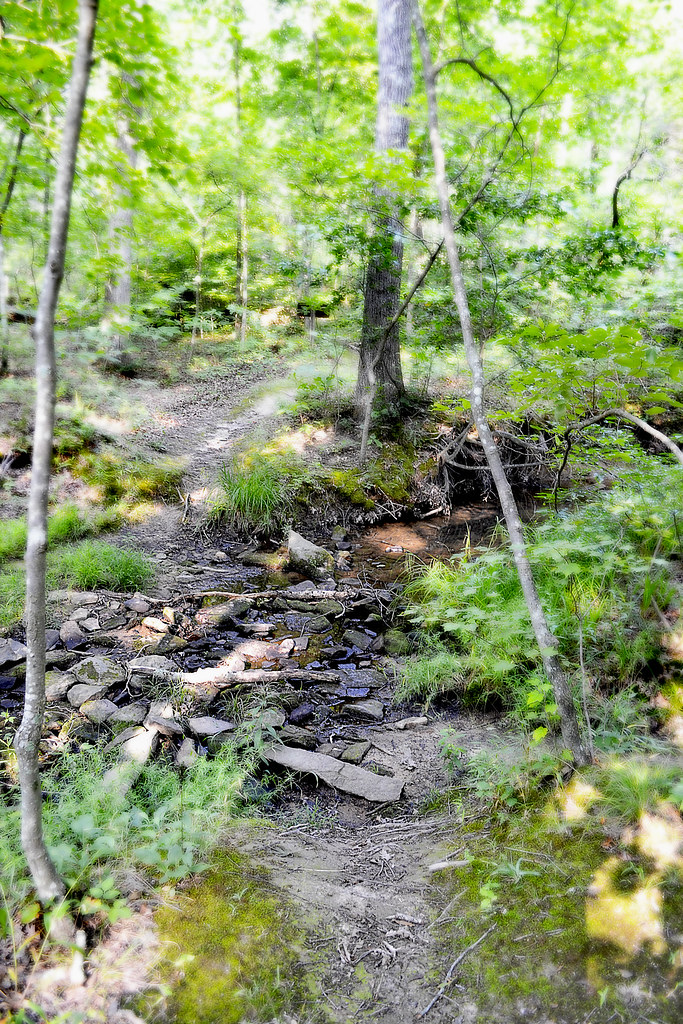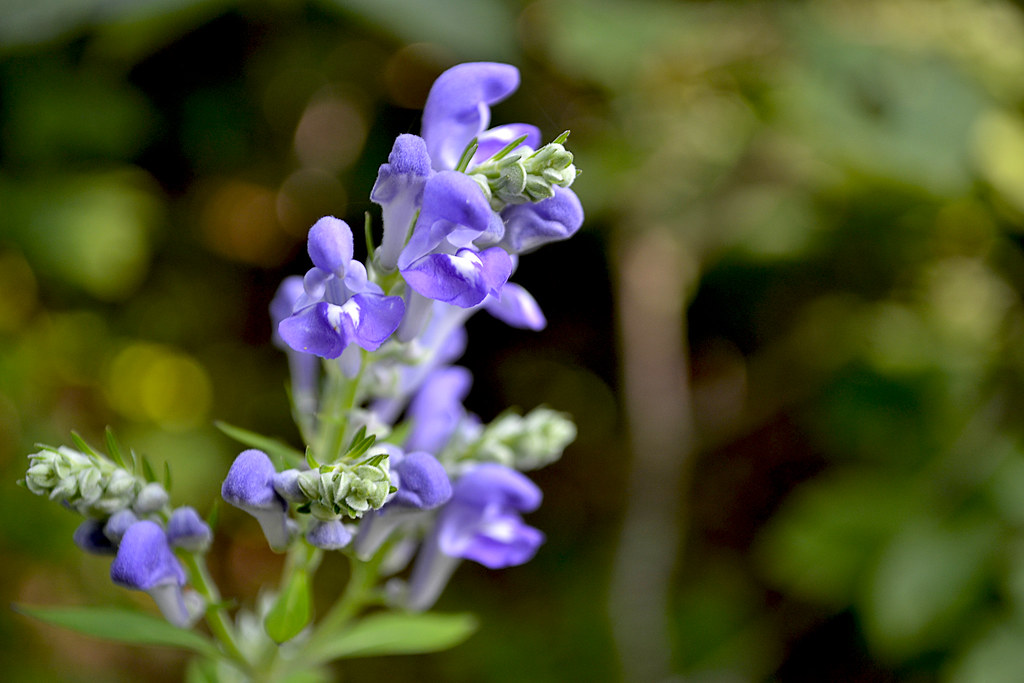Hike and climb among circus sized granite giants
 Elephant Rocks State Park draws its name from the colossal pink granite boulders, the largest of which has been named Dumbo and is estimated to tip the scales at 680 tons! You will find an area where these boulders seem to march like a line of elephants upon a barren granite hill which graces the center of the park. If you'd like to get really technical here these pink colossi are perched on a tor, which is Gaelic for rocky hilltop, so if that comes up in a final Jeopardy! round remember who to share your winnings with. On top of the tor, shown in the picture to the left, you may find interesting pools of water, seemingly carved directly out of the granite. These pools are actually referred to as tinajitas and are caused by physical and chemical weathering of the stone, sometimes these tinajitas may be several feet in diameter and provide a home to tadpoles or the hiker's arch-nemesis, mosquito larvae. I have seen some truly beautiful pictures of these circular depressions, filled with water and reflecting their surroundings, but alas... When we visited the park each of the tinajitas we visited were as dry as a bone.
Elephant Rocks State Park draws its name from the colossal pink granite boulders, the largest of which has been named Dumbo and is estimated to tip the scales at 680 tons! You will find an area where these boulders seem to march like a line of elephants upon a barren granite hill which graces the center of the park. If you'd like to get really technical here these pink colossi are perched on a tor, which is Gaelic for rocky hilltop, so if that comes up in a final Jeopardy! round remember who to share your winnings with. On top of the tor, shown in the picture to the left, you may find interesting pools of water, seemingly carved directly out of the granite. These pools are actually referred to as tinajitas and are caused by physical and chemical weathering of the stone, sometimes these tinajitas may be several feet in diameter and provide a home to tadpoles or the hiker's arch-nemesis, mosquito larvae. I have seen some truly beautiful pictures of these circular depressions, filled with water and reflecting their surroundings, but alas... When we visited the park each of the tinajitas we visited were as dry as a bone. You may also notice many carvings upon the central tor and even on a few of the granite elephants that reside there. Many of the quarry workers would carve their names and date into the granite here when they received the rank of Master Stone Cutter and you will find many dates from the late 19th century, standing as silent testament to the achievements of the men who cut into their igneous bodies. You may also notice growths on some of the stone here as well, called lichens and mosses, generally you will find both of these in sunnier areas. The lichens and mosses found growing here are another piece of the puzzle that develops the unique pattern of weathering demonstrated upon the elephant rocks within the park.
You may also notice many carvings upon the central tor and even on a few of the granite elephants that reside there. Many of the quarry workers would carve their names and date into the granite here when they received the rank of Master Stone Cutter and you will find many dates from the late 19th century, standing as silent testament to the achievements of the men who cut into their igneous bodies. You may also notice growths on some of the stone here as well, called lichens and mosses, generally you will find both of these in sunnier areas. The lichens and mosses found growing here are another piece of the puzzle that develops the unique pattern of weathering demonstrated upon the elephant rocks within the park. Let your feet and fingers do the walking on the Braille Trail
It is around those stone circus attractions that you will find the first trail ever designed for outdoor lovers with visual or physical disabilities in Missouri, which is fondly referred to as the Braille Trail. The one mile long Braille Trail consists of a fully paved trail featuring signs with braille and regular text, you may even download a MP3 file from the Missouri Department of Conservation that provides audio for each of the interpretive signs along the trail. The Braille Trail loop (circular trail) is a fantastic way to explore the park and as you make your way along you will find spurs (offshoot trails) that lead to additional areas that you may explore, some of these spurs are handicapped accessible, but not all.
Explore the ruins and history of the old quarry
 One such spur is the Engine House Ruins Trail, which is less than a half of a mile long and connects to the Braille Trail in two spots, so if you miss the first offshoot, you can catch the other. Along this trail you will find the remains of the old Engine House, which was constructed here to repair and maintain the quarry's railroad engines. Here you can still find the old rails, now overgrown and sunken into the earth, that would have carried loads of granite from many of the local quarries to the larger railroads, such as the St. Louis, Iron Mountain and Southern Railroad, which were located some miles to the east. The building itself is eerily beautiful with the seemingly random pattern of mortared junctions really showcasing the individual stones fashioned to create it. It feels like you could almost hear the hissing of the old steam engines that would visit here if you listened closely enough...
One such spur is the Engine House Ruins Trail, which is less than a half of a mile long and connects to the Braille Trail in two spots, so if you miss the first offshoot, you can catch the other. Along this trail you will find the remains of the old Engine House, which was constructed here to repair and maintain the quarry's railroad engines. Here you can still find the old rails, now overgrown and sunken into the earth, that would have carried loads of granite from many of the local quarries to the larger railroads, such as the St. Louis, Iron Mountain and Southern Railroad, which were located some miles to the east. The building itself is eerily beautiful with the seemingly random pattern of mortared junctions really showcasing the individual stones fashioned to create it. It feels like you could almost hear the hissing of the old steam engines that would visit here if you listened closely enough..."Missouri Red" quarried here is still found in Missouri & beyond
 As you continue through the park you'll also find a spectacular overlook that provides a beautiful vantage of the old quarry that existed within the park. It has filled with decades of rain water and its steep sides clearly show the scars of the industry that shaped the entire area around the park, even factoring into the name of the nearby city of Graniteville, where you can find quarries that are still running today. It is in areas like this that a man could find himself taking home nearly $5.00 a day by cutting seventy blocks a day in the 1890's. The "Missouri Red", the trade name given to the granite products quarried from this area, can be found right here in Missouri, within the paving stones of some old St. Louis streets, the piers of the Eads Bridge and in the columns of the Missouri Governor's mansion, the granite was also shipped throughout the United States. As you soak in the eagle eye view available here take notice of the beautiful black oak and shag bark hickory trees that grow in the granitic soil here at Elephant Rock State Park.
As you continue through the park you'll also find a spectacular overlook that provides a beautiful vantage of the old quarry that existed within the park. It has filled with decades of rain water and its steep sides clearly show the scars of the industry that shaped the entire area around the park, even factoring into the name of the nearby city of Graniteville, where you can find quarries that are still running today. It is in areas like this that a man could find himself taking home nearly $5.00 a day by cutting seventy blocks a day in the 1890's. The "Missouri Red", the trade name given to the granite products quarried from this area, can be found right here in Missouri, within the paving stones of some old St. Louis streets, the piers of the Eads Bridge and in the columns of the Missouri Governor's mansion, the granite was also shipped throughout the United States. As you soak in the eagle eye view available here take notice of the beautiful black oak and shag bark hickory trees that grow in the granitic soil here at Elephant Rock State Park.Look for old "Plug and Feather" tools
 Traveling the Braille Trail around the over 131 acre state park, you'll notice large piles of granite scattered here and there. You will undoubtedly notice that many of these granite stones bear marks of an ancient technique for splitting the dense and tough stone called "plug and feather". The plug and feather technique has been used since the pyramid builders of ancient Egypt (and maybe even earlier). It is a brilliantly simple concept and requires only a few tools to pull off, a metal wedge (called a plug) and two metal shims (referred to as the feathers). A hole is drilled into the stone along a drawn line, which is where the stone cutter wishes the large block to split, then the feathers are inserted and the plug is then placed between the two feathers. Generally there will be multiple holes drilled and multiple pairings of feathers and plugs along the intended split line. At this point the stone mason will begin to strike each plug in succession moving down the intended split line, which causes the feathers to move outward from the center as the plug is driven, continuing to strike until the stone relents and fractures along the line. If you are careful and very observant you may even find some of the old feather and plugs that the quarry workers left behind in some of the holes! The picture to the right shows the fracture of the stone and unused holes as well where the masons looked to split the slab further. However, not all of the holes you find in these rock where placed there to split the stone, some are the results of core samples, taken to determine the quality of the granite.
Traveling the Braille Trail around the over 131 acre state park, you'll notice large piles of granite scattered here and there. You will undoubtedly notice that many of these granite stones bear marks of an ancient technique for splitting the dense and tough stone called "plug and feather". The plug and feather technique has been used since the pyramid builders of ancient Egypt (and maybe even earlier). It is a brilliantly simple concept and requires only a few tools to pull off, a metal wedge (called a plug) and two metal shims (referred to as the feathers). A hole is drilled into the stone along a drawn line, which is where the stone cutter wishes the large block to split, then the feathers are inserted and the plug is then placed between the two feathers. Generally there will be multiple holes drilled and multiple pairings of feathers and plugs along the intended split line. At this point the stone mason will begin to strike each plug in succession moving down the intended split line, which causes the feathers to move outward from the center as the plug is driven, continuing to strike until the stone relents and fractures along the line. If you are careful and very observant you may even find some of the old feather and plugs that the quarry workers left behind in some of the holes! The picture to the right shows the fracture of the stone and unused holes as well where the masons looked to split the slab further. However, not all of the holes you find in these rock where placed there to split the stone, some are the results of core samples, taken to determine the quality of the granite.Don't get lost in "The Maze"
 One of the last spurs that you will find off of the Braille Trail is an area nicknamed "The Maze" where you can wander and explore a section of the trail that features scattered boulders that would beckon "Climb me..." if they could speak. I spent a good amount of time here, bouldering, leaping, wedging myself into crags and cracks and generally acting like my old twelve-year-old self, however my now older body would have a serious discussion with me the following morning, just to remind me of how old I truly am. You could easily spend the bulk of your hike here trying to summit each of the boulders, each of which seems to present you with a different brain teaser of what method to use to climb them. Also keep in mind, it can be dangerous climbing on rocks and leaping from place to place. Any water on the surface of these stones can easily cause you to loose footing and slip as well, that beautiful pink granite makes a pretty slick wet surface, so be careful!
One of the last spurs that you will find off of the Braille Trail is an area nicknamed "The Maze" where you can wander and explore a section of the trail that features scattered boulders that would beckon "Climb me..." if they could speak. I spent a good amount of time here, bouldering, leaping, wedging myself into crags and cracks and generally acting like my old twelve-year-old self, however my now older body would have a serious discussion with me the following morning, just to remind me of how old I truly am. You could easily spend the bulk of your hike here trying to summit each of the boulders, each of which seems to present you with a different brain teaser of what method to use to climb them. Also keep in mind, it can be dangerous climbing on rocks and leaping from place to place. Any water on the surface of these stones can easily cause you to loose footing and slip as well, that beautiful pink granite makes a pretty slick wet surface, so be careful!Pay homage to those who served in WWI
As you begin or end your journey on the Braille Trail you may notice a poem carved into a large granite rock face. The carving is weathered and somewhat hard to read, but if you concentrate and focus you will find that these poetic words were carved to pay respect to those who did not come home from World War I in 1918, "In honor of our nation's brave that sleeps over the wave, they died that we be free no more war to be 1918."
Pro-Tips for Elephant Rocks State Park
 Elephant Rocks State Park is an extremely unique and beautiful park, so don't be surprised to find other outdoor enthusiasts filling the park on the same day you arrive. The entire area is particularly beautiful in the fall as the leaves begin to change, the black oak and shag bark hickory put on quite a display of oranges, reds, and every shade between. Be sure to bring a camera, you'll certainly want to take some pictures with these behemoths and maybe even shoot a quick selfie on some of the scenic overlooks from the tor (remember what a tor is... and remember to cut me in on that final Jeopardy! question...). Let the kids (and the kids at heart) play, explore and just generally have fun... But be careful, the beautiful pink granite here becomes slick as snot with a bit of water and remember falls onto solid rock hurt and can easily break bones. Finally, bring a picnic lunch. There are a great deal of picnic areas at Elephant Rocks, be sure to take some time out to reconnect with your loved ones and just sit back, eat and talk about just how awesome Elephant Rocks State Park is. Happy trails and thank you for reading!
Elephant Rocks State Park is an extremely unique and beautiful park, so don't be surprised to find other outdoor enthusiasts filling the park on the same day you arrive. The entire area is particularly beautiful in the fall as the leaves begin to change, the black oak and shag bark hickory put on quite a display of oranges, reds, and every shade between. Be sure to bring a camera, you'll certainly want to take some pictures with these behemoths and maybe even shoot a quick selfie on some of the scenic overlooks from the tor (remember what a tor is... and remember to cut me in on that final Jeopardy! question...). Let the kids (and the kids at heart) play, explore and just generally have fun... But be careful, the beautiful pink granite here becomes slick as snot with a bit of water and remember falls onto solid rock hurt and can easily break bones. Finally, bring a picnic lunch. There are a great deal of picnic areas at Elephant Rocks, be sure to take some time out to reconnect with your loved ones and just sit back, eat and talk about just how awesome Elephant Rocks State Park is. Happy trails and thank you for reading!Directions
More Information:
Local Treks on facebook
Missouri Department of Conservation: Elephant Rocks Webpage
MO State Parks: Elephant Rocks Webpage
MO State Parks: Teacher's Guide to Elephant Rocks
MO State Parks: Elephant Rocks State Park Trails
MO State Parks: General Information
- Braille Trail Map (1 mile)
- Engine House Ruin Map (0.40 mile)
Missouri State Parks.net: Elephant Rocks
Wikipedia: Plug and Feather


